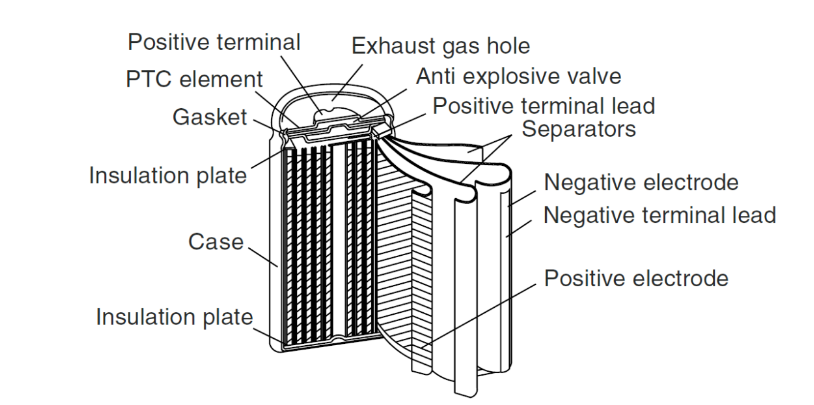Cylindrical lithium batteries are divided into lithium iron phosphate, lithium cobalt, lithium manganese, cobalt-manganese hybrid, ternary material different systems, the shell is divided into steel shell and polymer two kinds of, different material system battery has different advantages.
| Cell type | nominal voltage(V) | nominal capacity(mAh) | charging temperature(℃) | discharge temperature(℃) | Charging Current(A) | discharge current(A) |
| ICR18650 | 3.7V | 2200mAh | 0~45℃ | -40℃~+60℃ | 2.2A(1C) | 10A(normal temperatures5C) |
| ICR18650 | 3.7V | 2500mAh | 0~45℃ | -40℃~+60℃ | 2.5A(1C) | 25A(normal temperatures10C) |
| ICR18650 | 3.7V | 3000mAh | 0~45℃ | -40℃~+60℃ | 3.0A(1C | 15A(normal temperatures5C) |
| ICR21700 | 3.7V | 4000mAh | 0~45℃ | -40℃~+60℃ | 4.0A(1C) | 40A(normal temperatures10C) |
| NCR18650B | 3.6V | 3350mAh | 0~45℃ | -20~60℃ | 1.625A | 4.875A |
| INR18650-30Q | 3.6V | 3000mAh | 0~45℃ | -20~75℃ | 0.5C | 15A |
| IFR26650 | 3.2V | 3200mAh | -20℃~+45℃ | -40℃~+60℃ | 3.2A(1C) | 10A(normal temperatures3C) |
| IFR32700 | 3.2V | 5000mAh | -20℃~+45℃ | -40℃~+60℃ | 5.0A(1C) | 25A(normal temperatures5C) |
| IFR26650 E3400 | 3.2V | 3400mAh | 0~60℃ | -10~60℃ | 2.0V | 10.2A |
Cylindrical lithium batteries are divided into lithium iron phosphate, lithium cobaltate, lithium manganese manganate, cobalt-manganese hybrid, ternary materials, different systems, the shell is divided into two kinds of steel shell and polymer, different material system batteries have different advantages. At present, the cylindrical mainly steel shell cylindrical lithium iron phosphate batteries, the performance of this battery is high capacity, high output voltage, good charge/discharge cycling performance, stable output voltage, can be a large current discharge, electrochemical stability, safe to use, a wide range of operating temperatures, environmentally friendly, and is widely used in solar energy lamps and lanterns, lawn lamps and lanterns, back-up energy, power tools, toys and models.
The structure of a typical cylindrical battery includes: shell, cap, positive electrode, negative electrode, diaphragm, electrolyte, PTC element, gasket, safety valve and so on. Generally speaking, the shell is the negative terminal of the battery, the cap is the positive terminal of the battery, and the battery shell is made of nickel-plated steel.

Compared with soft pack and square lithium batteries, cylindrical lithium batteries have the longest development time, higher degree of standardization, more mature process, high yield and low cost.
- Mature production process, lower PACK costs, higher battery product yields, and good heat dissipation performance.
- Cylindrical batteries have formed a series of internationally unified standard specifications and models, mature technology, suitable for large-volume continuous production.
- Cylindrical specific surface area is large, good heat dissipation.
- Cylindrical batteries are generally sealed batteries, there is no maintenance problems during use.
- The battery shell has high pressure resistance, and there will be no phenomena such as expansion of square and soft-packed batteries in the process of using.
At present, the mainstream commercial cylindrical battery cathode materials are mainly lithium cobalt (LiCoO2), lithium manganate (LiMn2O4), ternary (NMC), lithium iron phosphate (LiFePO4), etc., and the different material systems have different characteristics of the battery.
Cylindrical battery anode materials are roughly divided into six types: carbon anode materials, alloy anode materials, tin-based anode materials, lithium-containing transition metal nitride anode materials, nanoscale materials, and nano anode materials.
- Carbon nanoscale materials anode materials: at present, the anode materials that have been practically used in lithium-ion batteries are basically carbon materials, such as artificial graphite, natural graphite, intermediate-phase carbon microspheres, petroleum coke, carbon fibers, pyrolysis resin carbon and so on.
- Alloy anode materials: including tin-based alloys, silicon-based alloys, germanium-based alloys, aluminum-based alloys, antimony-based alloys, magnesium-based alloys and other alloys, and there are no commercialized products at present.
- Tin-based negative electrode materials: tin-based negative electrode materials can be divided into two types: tin oxides and tin-based composite oxides. The oxides are oxides of various valence metals of tin. There are no commercialized products at present.
- Lithium-containing transition metal nitride anode materials, there are also no commercialized products at present.
- Nanoscale materials: carbon nanotubes, nano-alloy materials.
- Nano anode materials: nano-oxide materials